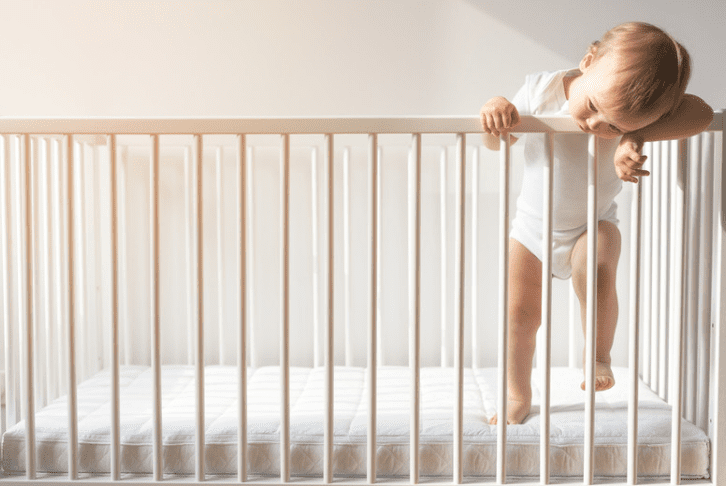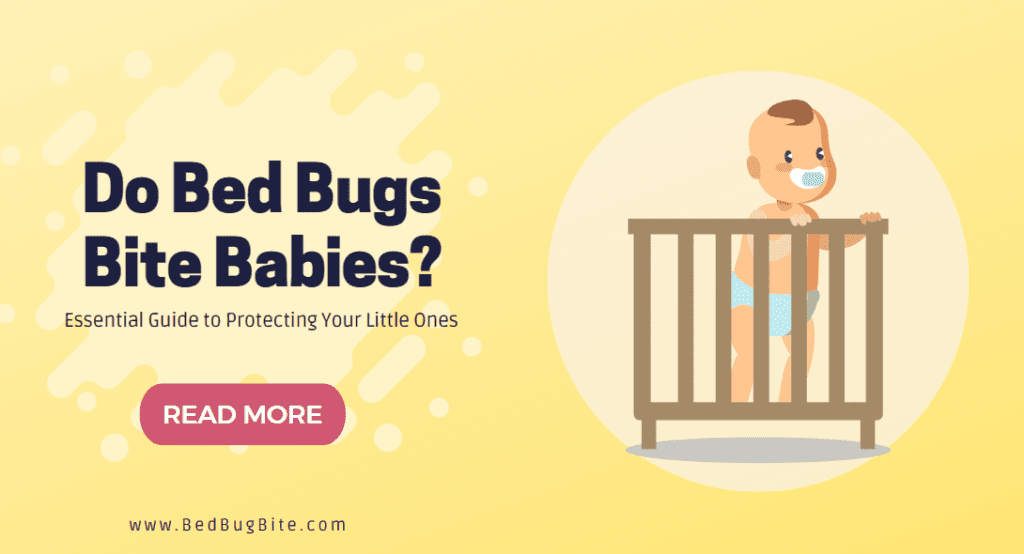Understanding the Bed Bug Threat in Homes
Do Bed Bugs Bite Babies? Bed bugs, small nocturnal insects known for their stealthy feeding habits, have become a widespread concern in homes across the globe. Particularly in family environments, the safety and well-being of our youngest members – infants – is paramount. Understanding the intersection between the secretive world of bed bugs and the vulnerability of babies is crucial for every caregiver. Click Here to Read More About Bed Bugs!
These pests, often mistaken for mere nuisances, pose a real threat to infants, who are sensitive to their bites and the potential allergic reactions they can trigger. With their limited mobility, babies are more exposed to prolonged bed bug infestations, especially in their sleeping areas. Recognizing this risk, it’s essential to delve into the nature of bed bugs, their behavior, and the impact they can have on our little ones.
The Hidden Challenge of Bed Bug Infestations
Bed bugs, Cimex lectularius, are experts at remaining undetected, hiding in the smallest crevices and only emerging at night to feed. This makes them particularly challenging to eradicate, as they can easily go unnoticed until their population has significantly grown. Their preference for human blood makes our living spaces, including nurseries, prime targets for infestation.
It’s not just about the physical effects of their bites. The presence of bed bugs can also disrupt the peaceful sleep of a baby, leading to restlessness and distress. Therefore, understanding bed bug behavior, identifying their presence, and taking prompt action to protect our infants becomes a responsibility we cannot overlook.
As we delve into this topic, it’s worth noting the extensive research conducted by the Environmental Protection Agency (EPA) on bed bugs. Their insights on bed bug biology and behavior provide a solid foundation for understanding these pests [EPA on Bed Bugs]. Drawing on such authoritative sources, we aim to offer the most accurate, helpful advice to ensure the safety and comfort of your baby in a bed bug-affected environment.
In this comprehensive guide, we’ll explore the essential measures to safeguard infants from bed bug bites, recognizing symptoms, and implementing effective prevention and treatment strategies. With a focus on accurate, actionable information, we’re here to help you navigate this challenging situation with confidence and care. Do Bed Bugs Bite Babies?
Understanding Bed Bug Behavior
Bed bugs, often lurking unseen in our homes, have behaviors and characteristics that are critical to understand for effective prevention and control. Especially when it comes to protecting infants.
Characteristics of Bed Bugs
Size, Appearance, and Typical Habitats
Bed bugs are small, with adults typically measuring about 5mm in length. They have flat, oval-shaped bodies, and are reddish-brown in color. These elusive pests prefer dark, hidden spaces close to their human hosts. They are often found in mattress seams, bed frames, behind wallpapers, and in other furniture crevices. Understanding these characteristics is key to identifying their hiding places in your home.
Feeding Habits and Targets
How and When Bed Bugs Feed, with a Focus on Vulnerability of Infants
A unique aspect of bed bug behavior is their feeding pattern. These insects primarily feed on human blood, usually at night when their hosts are asleep. This nocturnal feeding habit is particularly concerning for infants, who spend a lot of time sleeping and are thus more vulnerable to repeated bites. Bed bugs can feed unnoticed, leaving behind itchy and sometimes inflamed bite marks. Since infants have delicate skin and a developing immune system, they are more susceptible to severe reactions from these bites.

The Centers for Disease Control and Prevention (CDC) offers extensive information on the feeding habits and behavior of bed bugs, providing valuable insights for homeowners [CDC on Bed Bugs]. Using this reputable source, we aim to enhance your understanding of these pests. Ensuring you are well-equipped to protect your home and, importantly, your infants from the silent threat of bed bugs.
In the following sections, we’ll delve deeper into identifying bed bug bites on babies and understanding the potential risks they pose. Armed with this knowledge, you can create a safer, bed bug-free environment for your family.
Identifying Bed Bug Bites on Babies
Understanding how to identify bed bug bites on infants is a critical step in ensuring their safety and wellbeing. Given that babies cannot express their discomfort as older children or adults can. It’s vital for parents and caregivers to recognize the signs and take immediate action. Do Bed Bugs Bite Babies?
Common Signs and Symptoms
Describing Bite Marks and Reactions Specific to Infants
Bed bug bites typically appear as small, red, and sometimes clustered spots on the skin. On infants, these bites are often found on exposed areas such as the face, neck, arms, and hands. The bites can be distinguished from other skin irritations by their unique pattern. Often a line or cluster of bites, unlike the random pattern of mosquito bites. Infants might show signs of discomfort such as excessive crying, irritability, or trouble sleeping due to the itchiness and irritation caused by the bites.
Differentiating from Other Insect Bites
Comparing Bed Bug Bites with Other Common Insect Bites in Babies
Differentiating bed bug bites from other insect bites is crucial in determining the appropriate response. Unlike mosquito bites, which are usually isolated, bed bug bites often appear in a linear or clustered pattern. Additionally, bed bug bites can persist for longer periods and may take longer to heal in infants. It’s important to note that while bed bug bites are not known to transmit diseases. Their impact on an infant’s skin and overall comfort can be significant.
The Mayo Clinic provides comprehensive information on identifying and treating insect bites. Including those from bed bugs, which can be particularly useful for parents [Mayo Clinic on Insect Bites]. By incorporating this reliable medical insight, parents can be more prepared to accurately identify bed bug bites and respond effectively. Do Bed Bugs Bite Babies?
Recognizing the signs of bed bug bites and differentiating them from other insect bites is a key step in managing a bed bug situation, especially when it involves the health and comfort of infants. In the following sections, we’ll explore the potential risks associated with bed bug bites on infants and the proactive measures that can be taken to protect them.
The Risks of Bed Bug Bites to Infants
Addressing the risks associated with bed bug bites on infants is not just about skin irritation. It encompasses a broader range of potential health and psychological concerns. Given the delicate nature of an infant’s skin and their developing immune system, the impact of bed bug bites can be more pronounced compared to adults.
Potential Health Concerns
Discussing Allergic Reactions and Secondary Infections
While bed bug bites are generally not dangerous, they can lead to allergic reactions in some infants. These reactions may manifest as excessive swelling, redness, and itchiness around the bite site. In severe cases, it could lead to anaphylactic reactions, which require immediate medical attention. Additionally, due to the itching, infants might scratch the bite area, leading to secondary infections. These infections, if left untreated, can exacerbate the skin’s condition and lead to further complications.
Psychological and Comfort Impacts
Addressing Potential Sleep Disturbances and Stress in Infants
The psychological impact of bed bug infestations on infants is an often-overlooked aspect. The discomfort caused by bed bug bites can lead to significant sleep disturbances. A lack of restful sleep can, in turn, affect an infant’s mood, appetite, and overall development. Chronic sleep disruptions may also lead to increased stress levels in infants. Which can have a cascading effect on their overall health and well-being.
The American Academy of Pediatrics (AAP) provides valuable insights into the effects of insect bites on children, including sleep and behavioral impacts, which can be particularly useful for understanding the full scope of risks bed bug bites pose to infants [AAP on Insect Bites and Children]. Drawing from such authoritative pediatric resources, we aim to give parents a comprehensive understanding of the implications of bed bug bites on infants and how to best protect them.
Understanding the health and psychological risks associated with bed bug bites on infants is crucial in fostering a safe and nurturing environment. In the next sections, we will explore preventive measures and effective treatment options to ensure the well-being of your most vulnerable family members.
Preventive Measures in the Nursery
Creating a safe and bed bug-free environment for infants is crucial. The nursery, where babies spend a significant amount of time, should be a primary focus for bed bug prevention. Employing proactive strategies can significantly reduce the risk of infestation and ensure a healthy environment for your baby.
Creating a Bed Bug-Free Environment
Tips for Baby-Safe Bed Bug Prevention in Sleeping Areas
The first step in creating a bed bug-free nursery is to maintain a clean and clutter-free environment. As clutter can provide hiding spots for bed bugs. Regularly washing bedding, curtains, and soft toys in hot water and drying them on a high heat setting can kill bed bugs. Additionally, encasing the mattress and pillows in bed bug-proof covers can prevent these pests from infiltrating the baby’s sleeping area. It’s also advisable to inspect second-hand furniture or items for bed bugs before bringing them into the nursery.
Regular Inspection and Maintenance
Guidelines for Monitoring and Maintaining a Bed Bug-Free Nursery
Regular inspection is key in preventing bed bug infestations. This involves checking for signs of bed bugs, such as small brown spots (bed bug excrement) or actual bugs in and around the crib, mattress, and nearby furniture. Employing a handheld vacuum cleaner to clean the crib area and surrounding space can help remove any potential bed bugs or eggs. Additionally, consider seeking professional inspections periodically, as experts can identify and address potential infestation risks more effectively.
The National Pest Management Association (NPMA) offers comprehensive guidelines and tips for preventing and managing bed bug infestations in homes. Including specific advice for areas where infants are present [NPMA on Bed Bugs]. By integrating these expert recommendations, parents can ensure they are taking all necessary steps to maintain a bed bug-free nursery. Safeguarding their infant’s health and comfort.

In summary, the key to preventing bed bug infestations in the nursery lies in creating a clean, secure environment, complemented by regular inspection and maintenance. By staying vigilant and adopting these practices, parents can significantly reduce the likelihood of bed bug issues and ensure a safe, healthy space for their baby. In the upcoming sections, we’ll explore safe and effective treatment options should an infestation occur.
Safe and Effective Treatment Options
When it comes to treating bed bug infestations, especially in areas frequented by infants, safety and effectiveness are the top priorities. Choosing the right approach can ensure the health and well-being of your baby while effectively addressing the bed bug problem.
Home Remedies and Natural Solutions
Introducing Baby-Safe Home Treatments and Natural Repellents
For a mild bed bug problem, there are several home remedies and natural solutions that can be safely used in a baby’s environment. One effective method is the use of heat treatment, as bed bugs cannot survive high temperatures. Washing bedding and clothing at a temperature above 120°F can eliminate these pests. Vacuuming regularly, especially around the sleeping area, can also help in removing bed bugs and their eggs. Natural repellents like essential oils, although less effective than chemical treatments, can be used cautiously and in moderation to deter bed bugs.
Professional Extermination Methods
When to Seek Professional Help and What to Expect
In cases of severe infestation, it’s advisable to seek professional extermination services. Professionals have access to more effective and sometimes safer methods that are not available for general public use. They can employ a range of treatments from heat treatments to controlled use of pesticides, ensuring that the methods used are safe for a nursery setting. It’s important to communicate clearly that the treatment area is for an infant so that the exterminator can take all necessary precautions.
The Environmental Protection Agency (EPA) provides guidelines on safe and effective bed bug treatments, including considerations for spaces used by infants [EPA on Bed Bug Treatments]. This resource is invaluable for understanding what to look for in a professional service and how to prepare your home for treatment.
Choosing the right treatment method for a bed bug infestation in a baby’s environment requires careful consideration of safety and effectiveness. By exploring both home remedies and professional extermination options, parents can make informed decisions to protect their infants from bed bugs. Up next, we will discuss essential tips for parents to further enhance their bed bug prevention and treatment strategies.
Essential Tips for Parents
Equipping parents with practical and effective strategies is key to managing and preventing bed bug infestations. These tips not only help in safeguarding infants but also play a crucial role in maintaining a healthy and bed bug-free home environment.
Proactive Measures in Daily Routine
Integrating Bed Bug Prevention in Everyday Activities
Incorporating bed bug prevention into daily routines is an effective way to safeguard your home. Simple practices such as checking your clothing and belongings after returning from public places can minimize the risk of unknowingly bringing bed bugs into your home. When traveling, inspect hotel rooms or temporary accommodations for signs of bed bugs. Upon returning home, wash and dry all travel clothing at high temperatures. For infants, regularly inspecting baby gear, including strollers and car seats, is essential, as these items can also harbor bed bugs.
Educating Caregivers and Family Members
Spreading Awareness and Preventive Practices Among Those Who Interact with the Baby
It’s important for all caregivers and family members to be aware of bed bug prevention techniques. Educating them about the signs of bed bugs, the importance of regular inspections, and safe practices can significantly reduce the risk of infestation. Sharing information on how to properly inspect and clean second-hand toys and furniture can also be beneficial. Creating an informed circle of care around your baby ensures a collective effort in maintaining a bed bug-free environment.
The Centers for Disease Control and Prevention (CDC) provides valuable information on bed bug awareness and prevention, which can be a great resource for educating yourself and others [CDC on Bed Bug Awareness]. Utilizing such authoritative sources, parents and caregivers can access reliable information to protect their homes and loved ones from bed bug infestations.
By implementing these essential tips, parents can take proactive steps to prevent bed bug infestations and protect their infants. Understanding the importance of daily preventive measures and educating those around your baby creates a strong defense against these persistent pests. In our conclusion, we will summarize the key points covered and reinforce the importance of vigilance in protecting infants from bed bugs.
Conclusion: Vigilance and Care
In conclusion, the journey of protecting infants from bed bugs is an ongoing process that requires vigilance, awareness, and proactive measures. The information and strategies discussed in this guide are designed to empower parents and caregivers with the knowledge and tools necessary to create a safe and bed bug-free environment for their little ones.
Summarizing Key Points
We’ve explored the nature of bed bugs, how to identify their bites on infants, and the risks they pose. We’ve also discussed effective preventive measures for the nursery, safe treatment options for infestations, and essential tips for parents. Remember, regular inspections, maintaining a clean environment, and being cautious with second-hand items are crucial in preventing bed bug infestations.
Emphasizing the Importance of Continuous Vigilance and Care
Constant vigilance is key in the fight against bed bugs. Educating yourself and others, staying informed about the latest prevention and treatment methods, and acting swiftly at the first sign of an infestation can make all the difference. Remember, the health and well-being of your infant is paramount, and taking these steps can significantly contribute to their safety and comfort.
For additional resources and up-to-date information on bed bugs, the National Pest Management Association [NPMA] and the Environmental Protection Agency [EPA] offer comprehensive guides and tips. These resources can provide further insights and support in your efforts to protect your home and family from bed bugs.
By following the guidelines and tips provided in this guide, you can create a safer environment for your baby and ensure that your home remains a sanctuary, free from the hidden dangers of bed bugs. Your vigilance and care are the best defenses against these pests, ensuring peace of mind and the well-being of your family.




